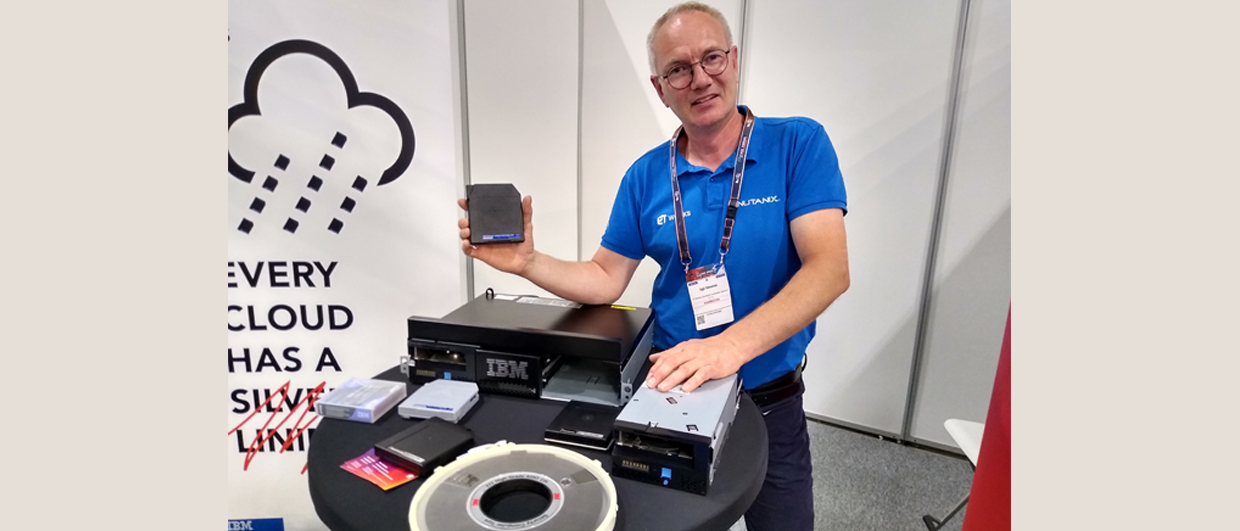Part 2: Early developments of marine vibrators for geophysical acquisition techniques made by PGS.
Once you know what you want in life…like a magnet you attract the resources necessary to manifest the world you desire.
Melissa Mojo Hunter, Pretty Poems to Ponder
PGS Marine Seismic Acquisition Technology
Sketch showing how the marine vibrator is towed behind the seismic vessel. PGS.
Two years after Petroleum GeoServices (PGS) was founded in 1991, the company started to look into alternatives to marine airgun arrays. A huge marine vibrator based on flextensional principles equipped with an electric motor drive was developed and tested at the Norsk Hydro operated Oseberg field in 1995. In the period from 1996 to 2001 this prototype was further developed and the motor was exchanged for an electromagnetic drive, which was tested in the Gulf of Mexico between 1999 and 2001.
A major challenge for marine vibrators has always been to compose a broadband source spectrum, and to generate sufficient low frequency energy is especially challenging. This issue forces the size of the marine vibrator so it is significantly larger than an airgun.
In 2007 PGS started to use Terfenol as the driving mechanism. The use of Terfenol-D was actually launched in a development project financed by Saga Petroleum in the early ’90s and the initial results were presented at the 1991 SEG meeting (Ursin-Holm et al., 1991). The Swedish company ABB had also performed experiments using Terfenol-D in 1983.
Flextensional marine vibrator equipped with an electromagnetic drive. Each source unit is the size of a man. PGS.
In the 1991 paper by Ursin-Holm et al. the main focus was to develop a source that could be used for site surveys and imaging of shallow marine sediments, with a source spectrum covering the bandwidth from 100 to 800 Hz. The nice feature of the Terfenol-D alloy is that a relatively small displacement along the major axis is converted to a much larger displacement along the minor axis. Typically, the Terfenol-D rod is surrounded by a flextensional shell. The 1991 test showed that this prototype source had a moderately flat spectrum with two major peaks (140 and 640 Hz), and an average peak output of approximately 1.2 bar-m. This signal strength is comparable to a small airgun (20 cubic inches). The 2007 version of the flextensional marine vibrator was tested in shallow water in 2012. Geokinetics has since used this source for several field trials, and denoted the source AquaVib.
In 2013, a new electromagnetic drive was developed which improved the low frequency response significantly, so that the new vibrator now provides a good bandwidth between 5 and 100 Hz.
Did You Miss the First Part?
Geophysical Technology: Marine Vibrators Part I
What is Terfenol-D?
Terbium (left) and Dysprosium (right). Wikipedia.
According to Wikipedia, Terfenol-D is an alloy material composed of terbium (Tb), dysprosium (Dy) and iron (Fe). It is magnetostrictive, which means that it will change shape when exposed to a magnetic field. This property is exploited to generate the vibrations for the marine Terfenol-D-based device that was developed between 1991 and 2007. The acronym Terfenol comes from Terbium, Iron (Fe) and Naval Ordnance Laboratory (where it was developed). The last letter (D) refers to Dysprosium. Both terbium and dysprosium are rare earth materials.
Snodgrass and McMasters (1997) states that Terfenol-D offers the highest strain of any magnetostrictive material at room temperature using practical driving fields; typically, up to 1.2 millistrain is achieved for a driving magnetic field of 100 kA/m. However, strains as high as 3.6 millistrain are possible if the Terfenol-D alloy is driven at mechanical resonance (Dapino, 2004). These strains are typically three orders of magnitude larger than, for instance, those of nickel.
Terbium is number 65 in the periodic table, and was discovered by Carl Gustav Mosander in 1843. The top three producers of this rare earth metal are China, Russia and Malaysia. In addition to Terfenol-D, terbium is used in several solid-state devices, low-energy lightbulbs, X-ray machines and laser devices. As a laser, it emits coherent light with a wavelength of 546 nm. Terbium is a soft material that can be cut by a knife.
Dysprosium is element number 66 in the periodic table and is also one of the rare earth metals. It was discovered by Paul-Emile Lecoq de Boisbaudran in 1886. The name is Greek and means ‘hard to get’! Today, dysprosium is used to produce permanent magnets that are used in electric vehicles, among other things. In 2011 electric vehicles contributed to 20% of the dysprosium market. The demand for the mineral has increased over the last decades and according to Hoenderdaal et al., 2013, 99% of it is mined in China. Since it takes several years to establish new mines it is not unlikely that there might be a shortage of dysprosium within a few years.
Improving Low Frequency Response in Marine Seismic Acquisition
Conventional marine seismic vibrators (the early hydraulically driven marine vibrators) typically have a poor signal strength below 30 Hz, especially when compared to conventional airgun arrays. The reason for this is that these types of sources have a very poor efficiency at low frequency. The only way to get good efficiency at low frequencies is to have a resonance in the lower frequency range. The resonances for the hydraulic sources were above the seismic band, so in the period from 2013 to 2017 one of the main challenges that the PGS marine vibrator team faced was to improve this response.
A flat source spectrum is achieved by combining two different marine vibrators: a Triton M source (left) and a Subtone M (right). The two sources are shown at the same relative scale. PGS.
By combining two sources, Triton M and the Subtone M (the M denotes a PGS source with the new electromagnetic driver), the source strength is improved significantly, especially for low frequencies. The clue to getting a good acoustic output was that each of the sources has two resonances, one in the low frequency end and one in the upper frequency range. The resonance in the low frequency range end is a result of the shell interacting with the surrounding water, while the second resonance is from the driver mechanism in the source itself. This type of system is the only known concept that can create a rather flat frequency response over a wide range of frequencies, making it a unique source for seismic applications. The two resonances for each source not only improve the acoustic output but also improve the efficiency, which in turn makes the sources more controllable, enabling them to use arbitrary signals with ‘high acoustic fidelity’. From a field test it has been found that the output for the new vibrator array (consisting of 4 Subtone elements and 8 Triton elements) would meet the requirement of 190 dB re 1 microPa/Hz@1m for 5–10 Hz and 200 dB for 10–100 Hz for a 5 second-long sweep. This is comparable to a 1,000 cubic inch airgun, although this comparison is not straightforward since the marine vibrator will be repeatable and have less self-generated noise.
The next step in this development is to build a full seismic array and test it in the field. Unfortunately, due to the major decline in the seismic market from 2013 to date, this project has been put on hold. The interest in marine vibrators, however, is increasing, and with an improving seismic market at the same time as the industry is facing more regulations, particularly related to impulsive sources, one may expect new opportunities for marine vibrator technology.
Flexible Marine Vibrator Array System
PGS.
The final stage of marine vibrator development, which was put on hold in 2016, showed that the required output of 5–100 Hz can be met. The developed marine vibrator array can be used in a towed mode (as shown to the right) or in a stationary mode for shallow waters or transition zones. The sweep length can vary from 5 to 40 seconds, and the depth range is from 2 to 30m. In the future it would also be possible to place units on unmanned surface vessels which would improve the flexibility further. New signal schemes together with continuous recording may also reduce the number of sources needed.
References:
Ursin-Holm, B., R. Tenghamn, R. Fritsvold and P.A. Osterholt, 1991, Development of a new improved marine vibrator based on Terfenol-D, SEG Expanded Abstract 1991, 796–799.
Dapino, M. J., 2004, On magnetostrictive materials and their use in adaptive structures, Structural Engineering and Mechanics, 17, No.3–4.
Snodgrass, J. D. and O. D. McMasters, 1997, Optimized TERFENOL-D manufacturing processes, Journal of Alloys and Compounds, 258, 24–29.
Hoenderdaal, S., L. Tercero, F. Marscheider-Weidemann and W. H.J.
Crijns-Graus, 2013, Can a dysprosium shortage threaten green energy technologies?, Energy, 49, 344–355.
Further Articles Related to Geophysics in Oil and Gas
Some recommended reading from GEO ExPro relating to the topic of geophysical seismic acquisition in oil and gas.
Next Generation Hydrocarbon Exploration
Stefano Volterrani, Tim Matava, Zakir Hossain, Shihong Chi and Brian W. Horn; ION E&P Advisors
Integrating technologies for basin analysis improves geological and geophysical models, enabling the next generation of hydrocarbon exploration.
This article appeared in Vol. 15, No. 5 – 2018
Applying Innovations in Geophysics to the Hydrocarbon Industry
Staff Writer
Regular GEO ExPro contributor Martin Landrø is Professor of Applied Geophysics at the Department of Petroleum Engineering and Applied Geophysics at the Norwegian University of Science and Technology in Trondheim, Norway. Here he discusses some of the more important innovations in the science of geophysics when applied to the hydrocarbon industry.
This article appeared in Vol. 12, No. 4 – 2015
Land Seismic Acquisition
Jason Criss & Andy Bull, INOVA Geophysical
The challenges ahead for land seismic acquisition.
This article appeared in Vol. 15, No. 1 – 2018
Advancing Geophysical Science
Josef Paffenholz, Chair SEAM Board of Directors
Propelling the science of geophysics through cooperation to meet the grand challenges of tomorrow.
This article appeared in Vol. 15, No. 4 – 2018





